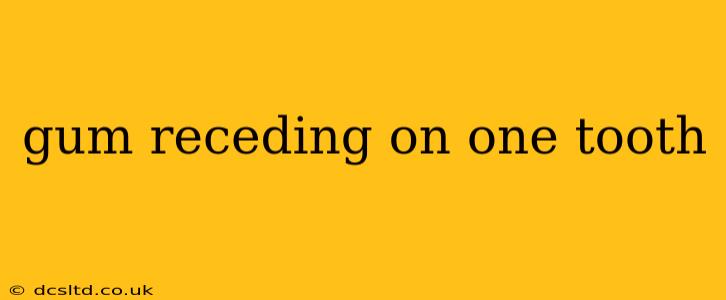Gum recession, where your gums pull back from your teeth, is a common dental problem. While it can affect multiple teeth, it's also possible to experience gum recession on just one tooth. This can be unsettling, but understanding the causes, treatment options, and preventative measures is crucial for maintaining good oral health.
What Causes Gum Recession on One Tooth?
Several factors can contribute to gum recession on a single tooth. It's often a combination of factors rather than one single cause. Let's examine some of the key culprits:
-
Aggressive Brushing: Brushing too hard or using a hard-bristled toothbrush can damage the gum tissue over time, leading to recession. This damage is often localized, affecting only one or a few teeth.
-
Improper Brushing Technique: Even with a soft-bristled toothbrush, incorrect brushing techniques can lead to gum recession. Horizontal scrubbing instead of gentle vertical strokes is a common offender.
-
Gum Disease (Periodontal Disease): This is a major cause of gum recession. Inflammation and infection destroy the supporting tissues around the teeth, causing the gums to recede. Often, this will affect multiple teeth but can sometimes be localized to a single tooth, especially if there's a pre-existing issue like a deep pocket or decay in that specific area.
-
Genetics: Some individuals are genetically predisposed to gum recession. Their gum tissue might be naturally thinner or more susceptible to damage.
-
Teeth Grinding (Bruxism): The excessive force from grinding or clenching teeth can wear down the tooth enamel and put stress on the surrounding gum tissue, potentially leading to recession. This can be localized to the teeth experiencing the most pressure.
-
Trauma: An injury to the mouth, such as a blow to the face or a chipped tooth, can also cause localized gum recession.
-
Misaligned Bite (Malocclusion): An improper bite can put excessive pressure on certain teeth, contributing to gum recession in those specific areas.
Can Gum Recession on One Tooth Be Reversed?
H2: Is it possible to reverse gum recession on just one tooth?
Unfortunately, reversing gum recession is not always possible, and the success of treatment depends on the severity and cause of the recession. Mild recession may be stabilized or improved with proper care and treatment. However, significant recession often requires more involved procedures.
Treatment Options for Gum Recession on One Tooth
The treatment approach will depend on the cause and severity of the recession. Options may include:
-
Improved Oral Hygiene: The first step is often improving your brushing technique and using a soft-bristled toothbrush. Your dentist can provide guidance on proper brushing and flossing techniques.
-
Scaling and Root Planing: If gum disease is present, this procedure involves removing plaque and tartar from the teeth and smoothing the tooth roots to reduce inflammation and promote healing.
-
Gum Grafting: This surgical procedure involves taking tissue from another part of the mouth (often the palate) and grafting it onto the affected area to cover the exposed roots. This is a common treatment for more severe recession.
-
Connective Tissue Graft: A more advanced technique involving grafting tissue from the palate to the gum line, often used to treat more severe recession or where additional gum tissue is needed.
-
Guided Tissue Regeneration (GTR): This involves placing a membrane over the exposed root to encourage the regrowth of gum tissue and bone.
-
Enamel Matrix Derivative (EMD): This protein-based material helps regenerate gum tissue and bone, often used in conjunction with other procedures.
Preventing Gum Recession on One Tooth (or Any Tooth!)
Prevention is key to maintaining healthy gums. Here’s how:
-
Gentle Brushing: Use a soft-bristled toothbrush and brush gently with short, vertical strokes.
-
Proper Flossing: Floss daily to remove plaque and food particles from between your teeth.
-
Regular Dental Checkups: See your dentist for regular checkups and cleanings. Early detection and treatment of gum disease are essential.
-
Mouthguard for Bruxism: If you grind your teeth, a mouthguard can help protect your teeth and gums from excessive force.
-
Healthy Diet: A balanced diet contributes to overall health, including oral health.
What are the long-term effects of untreated gum recession?
Untreated gum recession can lead to several problems, including increased tooth sensitivity, tooth decay, periodontal disease, and eventually tooth loss. It's crucial to seek professional dental care if you notice any signs of gum recession.
How can I tell if my gum recession is serious?
Signs of serious gum recession include significant gum line shrinkage, visible tooth roots, increased tooth sensitivity, loose teeth, and persistent bleeding or inflammation. If you notice any of these, consult your dentist immediately.
By understanding the causes, treatment options, and preventative measures associated with gum recession, you can take proactive steps to protect your oral health. Regular dental checkups and diligent oral hygiene are vital in preventing or managing this common dental issue. Remember to consult your dentist for a proper diagnosis and personalized treatment plan.
